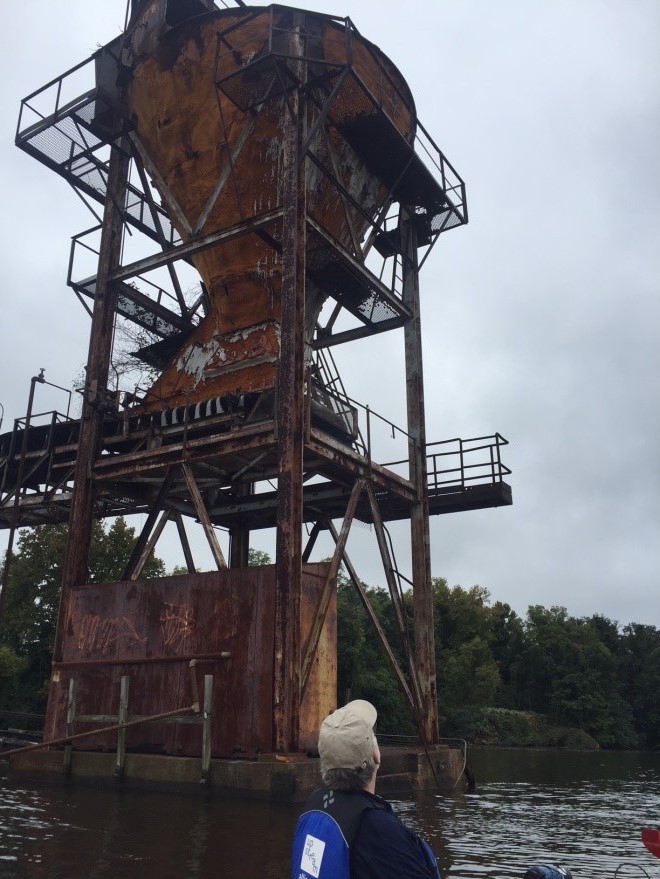Blog
25,000 Miles of Safe Swimming and Great Fishing

The Delaware River watershed encompasses an amazing network of 25,000 miles of flowing rivers and streams. Last weekend I had the privilege of paddling some 35 of those miles with a group of the region’s experts in outdoor education, environmental policy, conservation, and watershed science. All along the Delaware River from Trenton down to Philadelphia, and then up the Cooper River to Camden, we explored themes of pollution and recovery, conservation and development, recreation and community, hearing from a wealth of perspectives along the way.

Throughout the trip, I felt so much gratitude for the regulatory frameworks established by seminal laws like the U.S. Clean Water Act, the success of which made it possible for us to have such an enjoyable paddle downstream peppered with blue heron and bald eagle sightings, even as we passed numerous discharge points from active industries processing oil, gypsum, concrete, and chemical solvents. The river’s ability to support both industry and bald eagle habitat was evidence of the progress made by a generation of government officials, businesses, and environmental professionals, tracing back 50 years to the first Earth Day and the birth of the modern environmental movement.
Our first night around the campfire, Andy Kricun (Camden County Municipal Utilities Authority) and Tim Dillingham (American Littoral Society) introduced a compelling distinction between the substantial progress our society has made cleaning up water pollution (from end-of-pipe sources like sewage treatment plants), and the long way we still have to go to adequately address new sources (largely due to our footprint on the land).
And as we progressed downstream on our second day, I couldn’t help but notice the way development was reaching down to the water’s edge, encasing the natural shoreline in a sea of privately owned asphalt, broken by only a handful of public access points along its entire length. For every community we passed (about 19 cities and towns in total), there was a striking difference in how it approached the river, facing towards it or turning its back, embracing the waterfront for its vistas and recreational value, or more often than not, contributing to its legacy of neglect as a site for landfills, heavy industry, and sewage treatment.


Each community and landowner along the river’s edge was making its choice, and on the morning of the second day, Anne Hutchinson (Natural Lands) reminded us of how important those local relationships are in driving land use decisions that can protect or destroy a natural resource, and how tough it can be to influence local decisions without shared language and values. I took away how essential it is to connect with communities through slow, authentic engagement that reaches beyond traditional environmental issues to respond to their priorities for economic vitality, recreational opportunity, and quality of life. A broader suite of shared values is essential if our voices are going to be heard when it comes to the zoning and planning decisions that determine how land use decisions impact the health of our waterways and our access to them.
Along the journey, both Alice Baker (PennFuture) and Doug O’Malley (Environment New Jersey) underscored the policy and legal frameworks that give us the tools to push back against some of the most aggressive and egregious affronts to water quality and our most sensitive watershed lands. And while we cannot afford to shy away from the technical and scientific complexity that undergirds these important policies, David Kinney (Trout Unlimited) reminded us of the importance of effectively communicating to our public constituencies by tying these policies back to values, sharing in particular how the angler community across Pennsylvania has rallied in support of the state’s most exceptional and high quality streams as they seek to continue a generational tradition of fly-fishing possible only in the healthiest trout-supporting waters.

For all of our focus on “swimmable” and “fishable,” terms that policymakers define, on our second night, aboard a historic battleship in the Philadelphia harbor, Nick Pagon and Joanne Douglass (Philadelphia Waterborne) called out the discrepancy between what this fixed terminology dictates and all the ways in which communities need to self-determine and self-discover what their waterways mean to them. Are we reaching new constituencies if we’re talking about “swimmable and fishable” instead of “swimming and fishing”? Are we adequately addressing cultural barriers to access even as we focus on the physical obstacles of pollution and infrastructure?
To help us see the potential for disconnected communities to reengage with their waterways, Maggie McCann (Camden County Parks and Recreation) shared Camden’s story of waterfront redevelopment and Renaissance, a transformation of prisons to parks, and a level of civic and political support that Philadelphia can only envy and strive to replicate from across the river. Paddling up the Cooper River into Camden’s heart on the last day of the trip, we got to see these transformations and experience the vision they represent first-hand.

If there was any doubt about the potential that even these heavily impacted waters represented, friends from neighboring watersheds to the north (NYC Harbor) and south (Chesapeake Bay) offered validation as well as insights. Reflecting on decades of work addressing similar issues, their remarks underscored the importance of rolling out physical improvements incrementally in places where strong local support can ensure long-term viability, and offered a call to broaden our conversation to include more leaders among government and elected officials.
Informed by these partners and many more from across our grantee community and beyond, we are continuing to develop an emerging framework for new grantmaking that integrates select investments in outdoor programming, water quality monitoring, and policy advocacy towards securing high quality and accessible recreational uses for all 25,000 miles of the Basin’s waterways. I am so grateful for the privilege of drawing on the resources of the river and its many champions for inspiration, and like last week’s paddle, look forward to making this journey together!
Subscribe To Our Blog
Subscribe to our updates and always be in the know!
